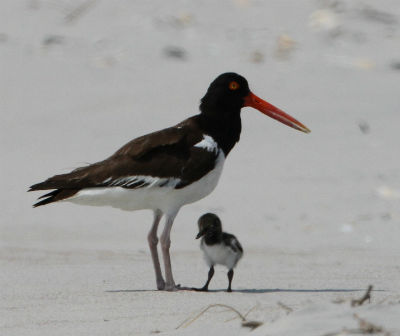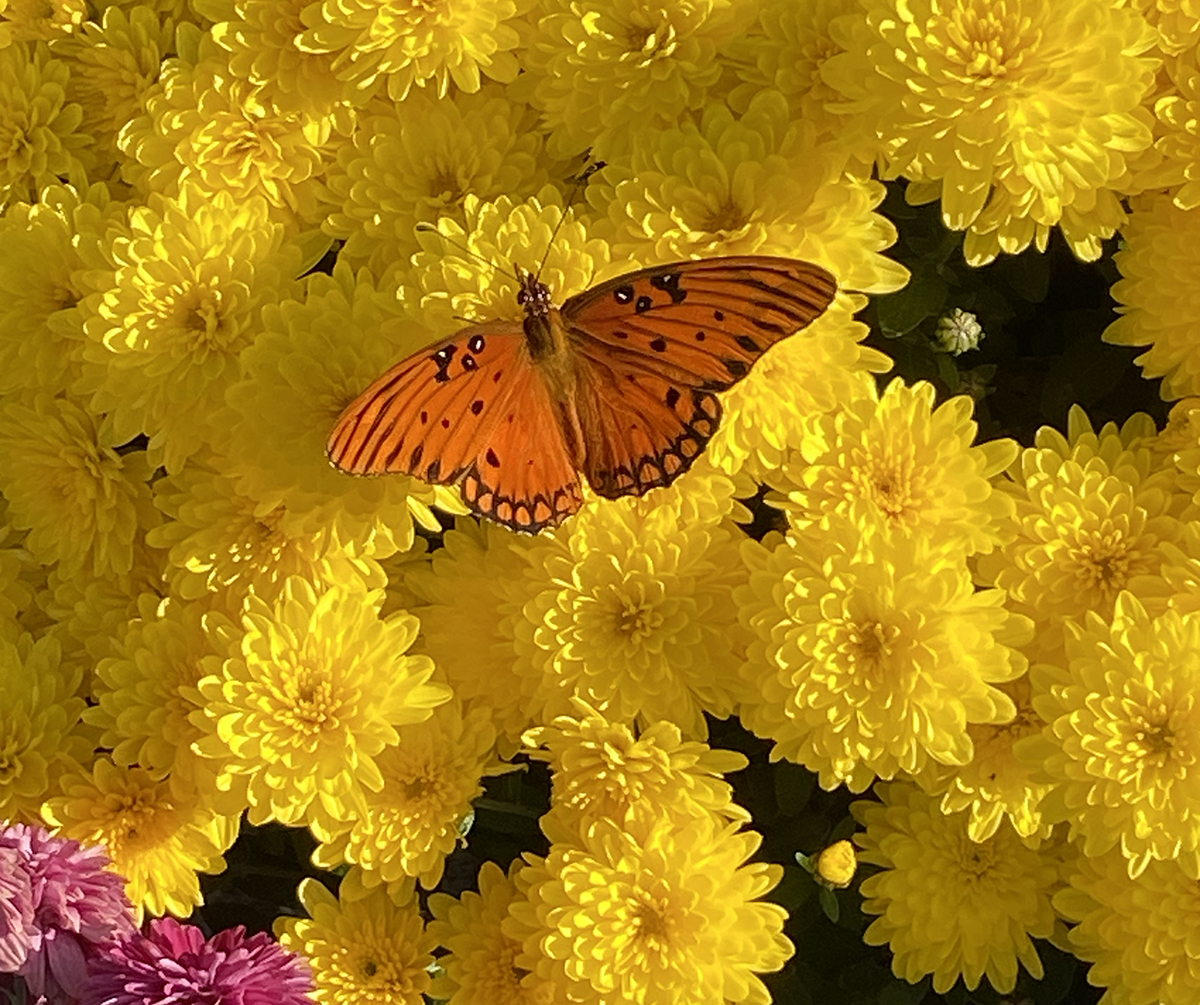 An oyster catcher chick stays close to its parent. Photo: Sam Bland |
A few weeks ago, I headed over to Bear Island at Hammocks Beach State Park near Swansboro to accompany my friend, Ranger Sarah Kendrick, in surveying shorebird nesting activity on the island. As we headed down the beach, an elegant black skimmer acted as our escort, gracefully gliding an inch or two above the water with its hair-trigger bill waiting to snap down on an unsuspecting fish.
Reaching the low, wide sandy spit of sand that is greeted by Bogue Inlet at the east end of the island, we notice that quite a few of the dainty least terns had already established scrapes in the sand and are sitting on eggs. The mating pairs are taking turns incubating the eggs and hunting for food. These birds perform acrobatic aerial maneuvers plunging head first into the water after small surface fish. Their tiny splash would make any Olympic diver envious. But the artistic disposition of their feeding flight is in stark contrast to the flight pattern employed to protect their eggs or chicks. Resembling a fighter jet, these terns will conduct fast swooping dives, lock in on their target and use their beak as a weapon. Anyone venturing too close to a nest or tern chick will be rewarded with a bloody scalp missing a tuft of hair. Since terns are colonial nesters, the whole group will join in to drive off any intruder; there is safety in numbers.
Supporter Spotlight
Scanning the tern colony with binoculars, we notice a larger black and white bird with bright yellow eyes and a long orange bill snuggled into the sand in a nesting posture. It was an American oyster catcher, nesting among the least terns to take advantage of their protective nature. A good number of oyster catchers nest on inactive oyster shell outcroppings that are found throughout the marsh waters behind the island. But in recent history, it has been rare for oyster catchers to nest on the sand spits at either end of the island.
Using a spotting scope, Kendrick was able to determine that the bird was sitting on three eggs. The gray eggs with brown speckles are well camouflaged in a shallow scrape decorated with bits and pieces of broken sea shells. Happily surprised, we hop back into the truck to check out the nesting activity at the west end of Bear Island bordered by Bear Inlet. The suitable nesting habitat at this end of the island is quite smaller, but we quickly notice least terns, Wilson plovers and willets, all exhibiting nesting behavior. Then tucked up near the base of a small dune we discover another oyster catcher sitting on two eggs. I know for most people this is no big deal, but for us, the prospect of baby oyster chicks scurrying about was quite exciting.
With our reconnaissance work completed, it was time for me to head home. Kendrick promised to give me a call as soon as the chicks chipped their way out of their speckled enclosures. As I drove home I realistically knew that the possibility of seeing any chicks was remote. It would be difficult for the eggs to go undetected by predators such as raccoons, foxes and even rat snakes that prowl the dunes eager to make a meal of bird eggs.
Forgetting about the oyster catcher eggs, a few weeks passed until I received a phone call. I was preparing to take an afternoon slumber when the phone rang and I let the answering machine serve as my proxy. A familiar voice told of chicks out and about being fed by the parents. I drove to the park in record time and raced from the parking lot down to the ferry dock. But alas, seeing the chicks was not meant to be, the ferry was pulling away from the dock. With the boat leaving, I gave a halfhearted wave of desperation for the boat to come back. Then the boat slowed down and turned, the captain generously returned to the dock and let me climb aboard. I gave the captain a big “thank you,” but I could tell that I wasn’t the first knucklehead to miss the boat.
Kendrick met me at the dock on the other side and we were soon scouring at the nesting area with a spotting scope looking for the chicks. Conspicuous as always, the parents were easy to spot. The chicks were close by, tucked away under a small clump of beach grass to take advantage of what little shade they could find. Looking through the long lens of my camera, they appeared to be sleeping. After a while, they began to stir and were soon wandering about. Even though they hatched only a day earlier, these precocious chicks were already venturing out with their parents and learning their new life.
Supporter Spotlight
The chicks look disproportionate with their long legs, but they were very steady on their feet and able to run like a sprinter. Compared to their parents, the bill on the chicks did not look out of place. It will take about sixty days for the bill to reach Pinocchio status and be useful for feeding. Until then, the parents will feed the chicks.
.JPG) |
As their name implies, oyster catchers like to eat oysters. An oyster catcher will use the blade-like bill to reach into a slightly opened oyster. Once the bill is inside the shell, the damage is done and so is the oyster. It may not seem like it, but eating bivalves can be risky. Oyster catchers have been reported to drown when a bivalve puts the squeeze on their beak and the tide rolls in. They will also eat other bivalves, worms, crabs and urchins.
Of the two oyster catcher nests, only the nest with the two eggs hatched out, the three eggs in the other nest most likely were victimized by a predator since the chicks were never seen. Hopefully they also hatched out and the chicks were guided undetected to the safety of the nearby marsh grass.
As with many other shorebirds, oyster catcher populations took a nose dive in the late 1800’s when they were hunted for food and their feathers were used to adorn garments. Today, oyster catchers face different threats. Development along our barrier islands has reduced the amount of suitable habitat, crowded beaches discourage nesting and poor water quality has diminished food sources.
The preservation of jewels like Bear Island is important to the survival of oyster catchers and other shorebirds. But it is also necessary to have these natural wonders where we can observe these creatures that nourish our spirit.







